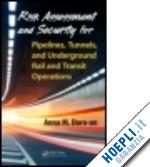IntroductionBackgroundRisk Acceptability of Terrorism and DisasterObjectiveScopePurposeHazards, Terrorism, and Weapons of Mass Destruction on Pipelines, Tunnels, and Underground Rail and Transit SystemsIntroduction Terrorism and Disasters against Pipelines, Tunnels, Underground Rail, and Transit SystemsUnderstanding the Basic Structure of Terror OrganizationBasic Recruitment Operations Terror Aspirant and Self-Radicalization Terror Member Terror-Suicide Bomber Technical Bomb and Improvised Explosive Devices Developer Terrorists Specializing in Chemical Threat Terrorists Specializing in Biological Threat Terrorists Specializing in Radiological and Nuclear Weapons Terrorist Intelligence Information and Reconnaissance Operation Terror Planner and Military Operation Planner Weapons of Mass DestructionChemical Explosives Acetone Peroxide Ammonium Nitrate Ammonium Nitrate–Fuel Oil Cyclonite (RDX) Dingu and Sorguyl Hexamethylenetetramine Dinitrate Hexanitroazobenzene Hexanitrodiphenylamine Hexanitrohexaazalsowurtzitane Lead Azide Lead Styphnate Mercury(II) Fulminate Nitrocellulose Nitroglycerin Octagen (HMX) Pentaerythritol Tetranitrate Picric Acid Plastic Explosives 2,4,6-TrinitrotolueneMechanical Components and Applications of Chemical Explosives Alginates Aluminum Powder Base Charge Blasting Caps Blasting Galvanometer Blasting Machine Blast Meters and Boosters Bridgewire Detonator Brisance Deflagration Delay Time and Element Detonation Shock Wave Detonation Wave Theory Selective Detonation Sympathetic Detonation Detonation Development Distance Electroexplosive Device Oxidizer and Oxygen Balance of Explosives Heat of Explosion Underwater Detonation Shock Wave of Underwater Detonation Gas Bubble Calculation of Explosives Hazards of ExplosivesChemical Threats as Poisonous Weapons and Lethal Dose (LD50) Chemicals’ LD50 Cyanide Cyanide LD50 Mustard Agents Nerve Agents Toxic Industrial AgentsArsenic Arsenic LD50 Inorganic Contaminants Organic ContaminantsBiological WeaponsRadiological and Nuclear Threats Radiological Dispersion Device Improvised Nuclear Device Nuclear Reactor Accident Nuclear WeaponNatural Disaster and Hazard Earthquakes Extreme Heat Floods Hurricanes Landslides and Mudslides Tornadoes Tsunami Volcanoes Wildfires Winter Weather Lightning Avalanches Ultraviolet Space WeatherCyberterrorismImplicationsReferencesIntroduction to Pipelines, Tunnels, Underground Rail and Transit Operations, Terrorism, and DisastersIntroductionDisaster and Acts of Terrorism against Pipelines, Tunnels, Underground Rail, and Transit Systems Security for Hazardous and Radioactive Material Transport Systems Fire, Explosion, and Detonation Vapor Cloud Explosion and Jet Flames Flash Point Flammability Range Autoignition Temperature Flame Speed and Burning Velocity Pool Fires Emission and Dispersion Dispersion Situation: Buoyancy Effects Dispersion Situation: Momentum Effects Dispersion Situation: Source Terms Dispersion Situation: Source Elevation Dispersion Situation: Meteorology and Topography Dispersion Situation: Building and Obstructions High Toxic Release Dust and Fragment Explosion Explosion Process3.2.6 Freight Capsule or Vessel Burst Pressure and Energy Distribution Explosion Destruction by Missiles Sources, Types, and Propagation of Missiles Number and Size of Missiles Velocity of Missiles Angle of Departure of Missiles Shape, Air Resistance, and Flight of Missiles Flying Glass Falling Masonry and GlassUnderground Freight Transportation through Pipelines, Tubular Rail, and Magnetic Levitation Automated Transportation System Automated Transportation Logistic System Underground Transportation Logistic System Pneumatic Capsule Pipeline for Underground Freight CargoCap Underground Container and Capsule Transport Systems Tubular Rail Magnetic Levitation Transportation SystemRailroad and Railway SystemsOil, Gas, and Other Hazardous Liquid Pipelines Unregulated Hazardous Material Liquid PipelinesUnderwater/Immersed Tunnel and Cross-River TunnelTransportation Tunnels Road Tunnels Transit and Rail TunnelsMine TunnelDrainage TunnelAqueductsDefense and Warfare TunnelsIllegal Underground TunnelsImplicationReferencesRisk and Vulnerability AssessmentIntroductionNational Aeronautics and Space Administration Risk Analysis and ManagementRisk Matrices FMECAs, FMEAs, and Fault Trees NASA Probabilistic Risk AssessmentStandard Homeland Security Risk Assessment and RAMCAP Plus Processes Fatalities and Serious Injuries Financial and Economic Impacts Vulnerability Analysis Threat Assessment Risk and Resilience Assessment Risk and Resilience ManagementDepartment of Defense Risk Assessment and Management Risk Reporting Matrix Security Risk CategoriesCARVER Matrix Criticality Accessibility Recuperability Vulnerability Effect RecognizabilityCARVER + ShockModel-Based Vulnerability AnalysisFreight Assessment SystemFederal Emergency Management Agency HAZUS-MHSecurity Vulnerability AssessmentAutomated Targeting System ATS-Inbound ATS-Outbound ATS-Passenger ATS-Land ATS-International ATS-Trend Analysis and Analytical SelectivitySandia National Laboratories Security Risk Assessment MethodsASME RA-S Probabilistic Risk AssessmentDevelopment of Prospect Theory Expected Utility Theory Prospect TheoryCumulative Prospect Theory Framing Effects Nonlinear Preferences Source Dependence Risk Seeking Loss Aversion Cumulative Prospect TheoryAuthor’s ThoughtsReferencesQuantitative Risk Estimation Model for Pipelines, Tunnels, Underground Rapid Rail, and Transit SystemsIntroductionElements of Risk Assessment Risk Estimation Development for Terrorism against Pipelines, Rails, and Tunnels Risk Estimation Development for Clandestine Fabrication and Transshipment of Weapons of Mass Destruction by Terrorists and Rebellious States to Endangering Homeland SecurityEvent Tree AnalysisEstimation of Risk and Risk Factors Calculation of Risk Rate Life Expectancy ModelsFault Tree Analysis Example of Event Tree AnalysisIdentification of HazardsTerrorism IntrusionFlash Fire ProbabilityFlash Fire: Ignition of Flammable MaterialsDetonation of Explosive DevicesLarge-Scale WMD DetonationPipelines, Tunnels, Underground Rail, and Transit Systems Adjacent to Human PopulationGuideway Short CircuitPipelines, Tunnels, Underground Rail, and Transit Systems Adjacent to Critical AssetsPipelines, Tunnels, Underground Rail, and Transit System RuptureSensor FailureMechanical and Electrical FailureCapsules, Underground Rail, and Transit System Derailment and CollisionHAZMAT Freight Container and Pipeline Damage, Collapse, and SpillRisk Index MatrixHuman Injury RiskImplicationReferencesRisk Acceptability Analysis Based on Quantitative Psychology of Intuitive JudgmentsIntroduction Public Perception of Risk: QuantitativePsychology of Intuitive Judgment and Cumulative Prospect Theory Voluntary or Involuntary Discounting Time Identifiability of Taking a Statistical Risk Controllability Avoidability of Risks Position in Hierarchy of Consequence Ordinary or Catastrophic Natural or Man-Originated Magnitude of Probability of Occurrence Strategic Determination of Risk AcceptabilityQuantitative Revealed Societal Preference Method Behavior and Risk Attitude Establishing Risk Comparison Factors Controllability of Risks Perceived Degree of Control System Control in Risk Reduction Systemic Control of Risk Control Factors Controllability of New Technological Systems Cost–Benefit Analysis Prerequisites for Risk Acceptance of Terrorist Attacks and Disaster Requirement for a MethodologyEstablishing the Risk Referent Multiple Risk Referents Risk Proportionality Factor Derivation from Risk References Risk Proportionality Derating Factors Degree of Systemic Control Conversion of a Risk Reference to a Risk ReferentImplicationReferences Strategic Intelligence Analysis, Military Support, and Military Intuitive Judgment in Safeguarding Pipelines, Tunnels, Underground Rail and Transit Operations and HomelandIntroductionIntelligence AnalysisStandard Intelligence Analy











